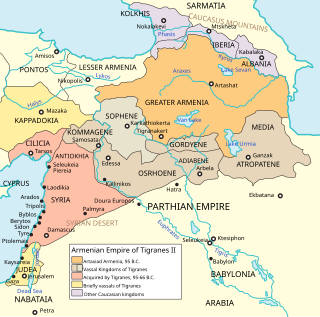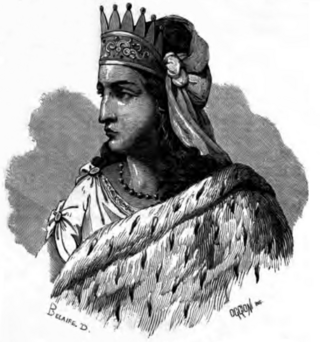
Marcus Opellius Macrinus was Roman emperor from April 217 to June 218, reigning jointly with his young son Diadumenianus. As a member of the equestrian class, he became the first emperor who did not hail from the senatorial class and also the first emperor who never visited Rome during his reign. Before becoming emperor, Macrinus served under Emperor Caracalla as a praetorian prefect and dealt with Rome's civil affairs. He later conspired against Caracalla and had him murdered in a bid to protect his own life, succeeding him as emperor.

Armenia, also the Kingdom of Greater Armenia, or simply Greater Armenia or Armenia Major sometimes referred to as the Armenian Empire, was a kingdom in the Ancient Near East which existed from 331 BC to 428 AD. Its history is divided into the successive reigns of three royal dynasties: Orontid, Artaxiad and Arsacid (52–428).

Artabanus IV, also known as Ardavan IV (Parthian:𐭓𐭕𐭐𐭍), incorrectly known in older scholarship as Artabanus V, was the last ruler of the Parthian Empire from c. 213 to 224. He was the younger son of Vologases V, who died in 208.

Vologases V was King of Kings of the Parthian Empire from 191 to 208. As king of Armenia, he is known as Vologases II. Not much is known about his period of kingship of Armenia, except that he put his son Rev I on the Iberian throne in 189. Vologases succeeded his father Vologases IV as king of the Parthian Empire in 191; it is uncertain if the transition of power was peaceful or if Vologases took the throne in a civil war. When Vologases acceded the Parthian throne, he passed the Armenian throne to his son Khosrov I.
The Arsacid dynasty, called the Arshakuni in Armenian, ruled the Kingdom of Armenia, with some interruptions, from 12 to 428. The dynasty was a branch of the Arsacid dynasty of Parthia. Arsacid kings reigned intermittently throughout the chaotic years following the fall of the Artaxiad dynasty until 62, when Tiridates I, brother of Parthian King Vologases I, secured Arsacid rule in Armenia as a client king of Rome. However, he did not succeed in establishing his line on the throne, and various princes of different Arsacid lineages ruled until the accession of Vologases II, who succeeded in establishing his own line on the Armenian throne, which ruled the kingdom until its abolishment by the Sasanian Empire in 428.

Tiridates I was King of Armenia beginning in 53 AD and the founder of the Arsacid dynasty of Armenia. The dates of his birth and death are unknown. His early reign was marked by a brief interruption towards the end of the year 54 and a much longer one from 58 to 63. In an agreement to resolve the Roman–Parthian conflict in and over Armenia, Tiridates I was crowned king of Armenia by the Roman emperor Nero in 66; in the future, the king of Armenia was to be a Parthian prince, but his appointment required approval from the Romans. Even though this made Armenia a client kingdom, various contemporary Roman sources thought that Nero had de facto ceded Armenia to the Parthian Empire.
Khosrov III the Small was the king of Arsacid Armenia c. 330–338/339.
Tiran known also as Tigranes VII, Tigranes or Diran was an Armenian prince who served as a Roman client king of Arsacid Armenia from 339 until 350. He was a contemporary of and is associated with the life of Sarkis the Warrior and his son, Martiros.
The Roman–Parthian Wars were a series of conflicts between the Parthian Empire and the Roman Republic and Roman Empire. It was the first series of conflicts in what would be 682 years of Roman–Persian Wars.

Vramshapuh was a noble of the Arsacid dynasty who served as the Sasanian client king of Armenia from 389 until his death in 414. He is mainly remembered for presiding over the creation of the Armenian alphabet by Mesrop Mashtots.

The Parthian war of Caracalla was an unsuccessful campaign by the Roman Empire under Caracalla against the Parthian Empire in 216–17 AD. It was the climax of a four-year period, starting in 213, when Caracalla pursued a lengthy campaign in central and eastern Europe and the Near East. After intervening to overthrow rulers in client kingdoms adjoining Parthia, he invaded in 216 using an abortive wedding proposal to the Parthian king Artabanus's daughter as a casus belli. His forces carried out a campaign of massacres in the northern regions of the Parthian Empire before withdrawing to Asia Minor, where he was assassinated in April 217. The war was ended the following year after Parthian victory at the Battle of Nisibis, with the Romans paying a huge sum of war reparations to the Parthians.
Artaxias IV or Artashir IV who is also known as Artaxias, Artashes, Artashes IV, Artashir, Ardasir and Artases was a prince who served as a Sassanid client king of eastern Armenia from 422 until 428. Artaxias IV was the last Arsacid king of Armenia and the last person to hold the crown of the ancient Armenian Kingdom.

Gaius Julius Sohaemus was a Roman client king of Armenia.
Khosrov I was a Parthian prince who served as a Roman client king of Armenia.

Khosrovidukht also transliterated Xosroviduxt was a princess of the Arsacid dynasty of Armenia, one of the client-kingdoms of the Roman Empire and a branch of the Arsacid dynasty of Parthia.

Khosrov II, also known as Khosrov the Brave was an Armenian king from the Arsacid dynasty in the mid-third century.

Anak the Parthian was a Parthian noble who, according to the Armenian tradition, was the father of Gregory the Illuminator, who converted Armenia to Christianity in the early fourth century. Anak is said to have killed King Khosrov of Armenia at the incitement of the Sasanians, leading to his own murder and the extermination of his family, except for the child Gregory, who was saved and taken to Roman territory. The details and historicity of this account have been debated by historians.
Vologases also known as Vologases III and Vagharsh III was a Prince who served as a Roman Client King of Arsacid Armenia. Vologases served as a co-king with his brother Arsaces III from 378 until 386.









